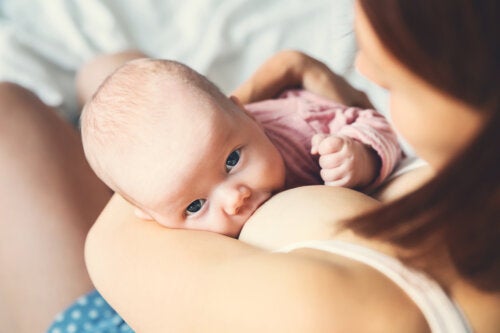Nipple Blisters: How to Treat Them
The presence of nipple blisters often hinders successful breastfeeding. In this article, learn how to prevent and deal with them.

During breastfeeding, nipple blisters are often a major nuisance for mothers. While there are ways to prevent or treat them, not all women are knowledgeable on the subject. Therefore, in this article, we’ll explore everything you need to know about nipple blisters so you can enjoy this beautiful bond between mother and child. Take note!
What are nipple blisters?
Nipple blisters are skin lesions of the breasts that are located in the nipple area. Although they don’t cause significant damage, they can be uncomfortable and even cause pain for the mother, making it difficult for the baby to feed.
Although they’re not milk blisters as such, they look like this. They’re the result of friction and skin growth around the milk ducts, which causes a small amount of breast milk to be retained behind the blister. This is why they look the way they do.
Why do they appear? In general, nipple blisters develop as a result of inadequate breastfeeding. One reason is that the newborn suckles the nipple too shallowly, which generates excessive pressure on a specific area of the breast. Another reason is that the baby latches onto the breast from the wrong angle.

An article published in the Journal of Midwifery & Women’s Health states that the most common causes of blisters may include the following:
- Problems with latch-on, suckling, or the baby’s tongue
- High milk production
- Excess pressure on a particular area of the breast
- Nipple thrush, which is an infection caused by a fungus that lives in the baby’s oral cavity
However, they’re also often associated with different conditions or diseases:
- Blockage of the milk ducts
- Inadequate friction
- Skin infections
- Contact dermatitis
Characteristics of nipple blisters from breastfeeding
Nipple blisters are irregular in shape and break easily when a little pressure is applied to them. While they can be very noticeable, they usually don’t cause much pain.
Specifically, they’re clear or yellowish elevations in the skin that are common during breastfeeding. These are generated at the end of the milk duct and contain fluid inside.
Ways to prevent nipple blisters
The appearance of milk blisters can be prevented with proper breastfeeding techniques and frequent breastfeeding. However, it’s recommended before starting to breastfeed to place a warm, moist compress on the nipple for 3 minutes. This helps to unblock the lactiferous ducts.
It’s also advisable to keep the nipple area moisturized to help reduce discomfort as the blisters evolve. Applying a cotton swab with olive oil or lanolin ointment can be quite effective and keep the area moist. This is indicated by a comparative study published in the journal Skin Pharmacol and Physiology.
Rotating the breastfeeding position reduces the likelihood of generating too much friction and, therefore, developing blisters on the nipples. In turn, avoiding tight-fitting clothing or underwire bras helps prevent the milk ducts from clogging.
Is a visit to the doctor necessary?
Nipple blisters aren’t usually painful, but they’re uncomfortable. They can usually go away on their own, particularly if breastfeeding continues, explains the Australian Breastfeeding Association.
If nipple blisters don’t improve with home care, it’s important to seek the advice of a health professional, such as a lactation consultant or physician. They can provide additional guidance and assess whether there’s an underlying infection or condition that requires treatment.
In addition, if the blisters don’t resolve spontaneously, your healthcare provider will prescribe appropriate measures to prevent duct blockage, mastitis, and breast engorgement.
Can the pain they cause be soothed?
Nipple blisters can lead to blockage or obstruction of the milk ducts. In fact, this is why they’re considered small obstructions or milk-filled cysts.
A painful nipple blister makes the mother unwilling to breastfeed. However, frequent breastfeeding is necessary to maintain the breast milk supply and to help clear the milk ducts.
Cold compresses can help relieve swelling and reduce pain. For this purpose, ice packs in a thin cloth can be used to avoid direct contact with sensitive skin.
The importance of medical monitoring during breastfeeding
In conclusion, nipple blisters aren’t usually serious, but they can be uncomfortable and cause difficulties during breastfeeding. In fact, nipple pain is a frequent reason for mothers to consult a doctor. Correcting the pumping or breastfeeding technique is essential, as nipple blisters will heal on their own in a few days.
Sometimes, an allergic reaction or a virus can cause blisters that you should pay attention to when breastfeeding. Therefore, if you have any doubts or concerns, don’t hesitate to consult your doctor.


